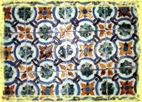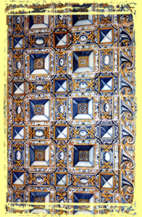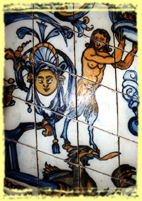



Museu Nacional do Azulejo

Spanish-Moorish Tile

Marcal de Matos

Diamond Point Pattern
MUSEU NACIONAL DO AZULEJO, LISBON, PORTUGAL
Barbara Rizza Mellin
Reinterpretation and reinvention are essential to the creative process. The great artistic Renaissance of the fifteenth and sixteenth centuries occurred, in part, because artists rediscovered the magnificent creations of classical Greece and reinterpreted what they found. The Impressionists, on the other hand, wanted to separate themselves from the past and reinvent art for art's sake. Whether as an artist, one seeks to recreate previous work or revolt against it, the past has always provided a strong motivation for creativity.
Ceramists looking for outstanding historical examples need look no further than the Museu Nacional do Azulejo, (As-zoo-lay'-shu), the tile museum of Lisbon, Portugal. This institution houses an extraordinary collection of tiles and ceramics reflecting centuries of artistic traditions.
The Portuguese have a long and deep appreciation of ceramic tiles; in fact, the beauty, variety, and abundance of tiles provide an identifying characteristic of this Iberian country. The vibrant ceramic tiles of blues, yellows, and teals decorate the facades of buildings, create wall-paper like patterns on interiors, surround doors and windows and even mark passageways on sidewalks and streets. In the profusion of repeated patterns, their decorative quality gives a special air to the most common settings. It is most fitting that this one-of-a-kind museum should be found in the picturesque older section of Lisbon, near the water's edge where the great merchants of antiquity traded wares with the world.
Housed in the former Madre de Deus Convent, built by Queen Leonor (1458 - 1525), the museum features tiles in their original settings, decorating staircases, walls and windows, as well as a collection of historic tiles garnered from around the world. In addition to the tiles, the Azulejo showcases changing exhibits of pottery, vases and vessels by world renown artists such as Galileo Chini (1873 - 1956) and his sons at the Fornaci S. Lorenzo (the Chini ceramics factory/studio in Italy). As an added attraction, among all these richly patterned ceramic masterpieces, is the convent itself, with wonderful arches, an inner courtyard, two cloisters and a chapel with painted ceiling.
Contemporary ceramists will appreciated the intricacies of design that appear on many of the tiles. For example, a beautiful Spanish Moorish tile from the sixteenth century with blue and gold geometric and vegetal motifs may motivate today's artisan to experiment with daring combinations of organic and inorganic shapes, perhaps causing one to visualize the whole created from minute patterns.
The larger cloister of the museum contains visual explanations of various historic tile making and decorating methods. As one display illustrates, early ceramists created a design on paper, pin-pricked the outline, and placed the paper on the unglazed tile. Then, using a bag formed from soft cloth and containing charcoal, they gently patted the paper, allowing the charcoal to transfer the design to the tile surface. Once the design could be seen, artists hand painted the pattern that was repeated with uncanny accuracy.
One creation inevitably influences another. (The word Azulejo is thought to have come from the Moorish word azzelij.) The Moorish influence on Portuguese and Spanish tiles is evident as curvilinear, natural shapes intertwine, emerging from beneath one another to weave a pattern of leaves or vine's tendrils. Often, the negative spaces emerge as stronger design elements than the positive shapes. In other examples, Dutch tiles with painted scenes of places and people, conjure up a wholly different images. In one panel, brown tiles from the Netherlands display a fleet of ships, their full blown sails billowing in the wind. Another group, produced for a dining hall, an elaborate still life with fruit and flowers takes shape, not unlike the paintings of the day. One may note that the blue on white tiles of Delft, Holland bear a marked resemblance to those of Portugal, while retaining a strikingly Netherlandish look. Other displays, like the scroll filled Florentine tiles from prerenaissance Italy, demonstrate their own geographic and cultural character.
Many of the tile works in the Azulejo Museum record the history of Lisbon. In one room of the cloister is a large display consisting of over one thousand tiles (5 meters x 4.65 meters) painted by the sixteenth century artist Marcal de Matos. This elaborately decorated retable of Our Lady of Life (Nossa Senhora da Vida), originally embellished the Church of St. Andrew with a cohesive composition of saints, angels, and figures of the nativity. Another work, this one made up of five hundred seventy six tiles, offers a fascinating panoramic view of Lisbon before the devastating 1755 earthquake. Finally, there is an intriguing panel taken from the ancient praia (beach) palace in Belem, the waterfront section of Lisbon. The panel's images of mythical griffins and phoenixes are set on uniformly horizontal planes. The circa 1650 tiles have been created as parallelograms instead of rectangles, ingeniously allowing them to be placed along the rise of a stairway.
To be sure, twentieth century artists are represented in the collection, Composicao Abstracta by Manuel Cargaleiro (b. 1927) consists of twelve tiles arranged in a vertical column two tiles wide. This circa 1954 work is representative of the twentieth century fascination with abstract visual images with triangles that traverse individual tile boundaries.
In many ways, the collection is timeless. The variety of patterns, repetition of designs, and juxtapositions of colors provide today's ceramists with a basis on which to build new interpretations, as well as to rediscover traditional ideas that remain vital and vibrant to today's modern sensibilities.
The Museu National do Azulejo provides a retrospective of ceramic tile techniques, a splendid collection of historic examples, and a wide variety of artistic treatments, all in one locale. Perhaps the works of the present, as they come to be exhibited here with those of the past, will inspire the artists of the future.
Address:
Museu National do Azulejo
Rua da Madre de Dues no. 4
Lisbon, Portugal
Telephone: (351) 218 14 77 47 or 218 14 77 99
Email: mnazulejo@ipm
Hours:
Tuesday 2 pm - 6 pm
Wednesday - Sunday 10 am - 6 pm

Tile Panel

Detail: Tile Panel

"Composiao Abstracta"

Panel de Azulejo di Padio